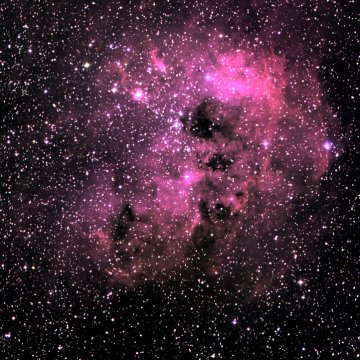Sh 2-236
Also called
IC 410Coordinates: (173.61°, -1.73°)
[ Catalog | Explorer | SIMBAD ]
Lying at the core of the Aur OB2 association, the great HII region IC 410 (associated with the radio source W8) surrounds the star cluster NGC 1893 and is sometimes called the Tadpole nebula because of tadpole like structures (the nebulae Sim 129 and Sim 130) visible in detailed images.
Avedisova lists 5 ionising stars (including 4 O-class stars). The hottest of these is the O5 V star HD 242908. She places Sh 2-136 in the star formation region SFR 173.63-1.70 along with the young stellar object IRAS 05198+3325.
A 2002 study states that NGC 1893 contains "at least five O-type stars".
There is an enormous range of distance estimates for NGC 1893. The most recent estimates appear to be converging around 3500 pc, consistent with a location in the Perseus arm.
Avedisova lists 5 ionising stars (including 4 O-class stars). The hottest of these is the O5 V star HD 242908. She places Sh 2-136 in the star formation region SFR 173.63-1.70 along with the young stellar object IRAS 05198+3325.
A 2002 study states that NGC 1893 contains "at least five O-type stars".
There is an enormous range of distance estimates for NGC 1893. The most recent estimates appear to be converging around 3500 pc, consistent with a location in the Perseus arm.
The very young open cluster NGC 1893 is considered to be the centre of the Aur OB2 association. NGC 1893 can be recognized as an extended region of loosely grouped early-type stars, associated with the Hii region IC 410 and obscured by several conspicuous dust clouds. NGC 1893 contains at least five O-type stars, of which two, HD 242908 and LS V +33 16 are main-sequence O5 stars, and therefore younger than ~ 3 Myr.[1]
Notes
1. ^ Marco, A. & Negueruela, I. (2002). "Pre-main-sequence stars in the young
open cluster
Distance estimates
3200 pc [1982ApJS...49..183B]6000 pc [2002A&A...389..871D]
6025 pc [2001AJ....121.2075M]
3250 pc +/- 200 [2007MNRAS.380.1141S]
4300 pc [1991MNRAS.253..649T]
4800 pc [1993A&AS...99...15F]
3340 pc +/- 460 [1984NInfo..56...59A]
3600 pc +/- 200 [2011A&A...527A..77P]
Links
[ DSS | ADS | ADS Abstract ]
map | book | blog | gallery | sources

Most of the sources used to create these nebula descriptions are listed in the
notes section for each description. In some cases,
for example the Avedisova, Humphreys and Reed catalogs, the source is used extensively and is not listed in the
individual nebula descriptions. See this catalog overview
for more information on the catalogs and the general sources used
to create these descriptions and this introduction to HII regions
on the general history of this area of astronomy.
This image was created using the POSS-II/UKSTU data of the Digitized Sky Survey and SuperCOSMOS using the process described here.
According to my correspondence with the Royal Observatory Edinburgh and the Space Telescope Science Institute, I am allowed to use the POSS-II/UKSTU data to create and display images for non-commercial purposes so long as I include this fine print for the SuperCOSMOS data:
Use of these images is courtesy of the UK Schmidt Telescope (copyright in which is owned by the Particle Physics and Astronomy Research Council of the UK and the Anglo-Australian Telescope Board) and the Southern Sky Survey as created by the SuperCOSMOS measuring machine and are reproduced here with permission from the Royal Observatory Edinburgh.
and this acknowledgement taken from the DSS site:
The Digitized Sky Surveys were produced at the Space Telescope Science Institute under U.S. Government grant NAG W-2166. The images of these surveys are based on photographic data obtained using the Oschin Schmidt Telescope on Palomar Mountain and the UK Schmidt Telescope. The plates were processed into the present compressed digital form with the permission of these institutions.
The Second Palomar Observatory Sky Survey (POSS-II) was made by the California Institute of Technology with funds from the National Science Foundation, the National Geographic Society, the Sloan Foundation, the Samuel Oschin Foundation, and the Eastman Kodak Corporation.
The UK Schmidt Telescope was operated by the Royal Observatory Edinburgh, with funding from the UK Science and Engineering Research Council (later the UK Particle Physics and Astronomy Research Council), until 1988 June, and thereafter by the Anglo-Australian Observatory. The blue plates of the southern Sky Atlas and its Equatorial Extension (together known as the SERC-J), as well as the Equatorial Red (ER), and the Second Epoch [red] Survey (SES) were all taken with the UK Schmidt.
The "Second Epoch Survey" of the southern sky was made by the Anglo-Australian Observatory (AAO) with the UK Schmidt Telescope. Plates from this survey have been digitized and compressed by the ST ScI. The digitized images are copyright ? 1993-5 by the Anglo-Australian Observatory Board, and are distributed herein by agreement.
The "Equatorial Red Atlas" of the southern sky was made with the UK Schmidt Telescope. Plates from this survey have been digitized and compressed by the ST ScI. The digitized images are copyright ? 1992-5, jointly by the UK SERC/PPARC (Particle Physics and Astronomy Research Council, formerly Science and Engineering Research Council) and the Anglo-Australian Telescope Board, and are distributed herein by agreement.
The compressed files of the "Palomar Observatory - Space Telescope Science Institute Digital Sky Survey" of the northern sky, based on scans of the Second Palomar Sky Survey are copyright ? 1993-1995 by the California Institute of Technology and are distributed herein by agreement. The compressed files of the "Palomar Observatory - Space Telescope Science Institute Digital Sky Survey" of the northern sky, based on scans of the Second Palomar Sky Survey are copyright ? 1993-1995 by the California Institute of Technology and are distributed herein by agreement.